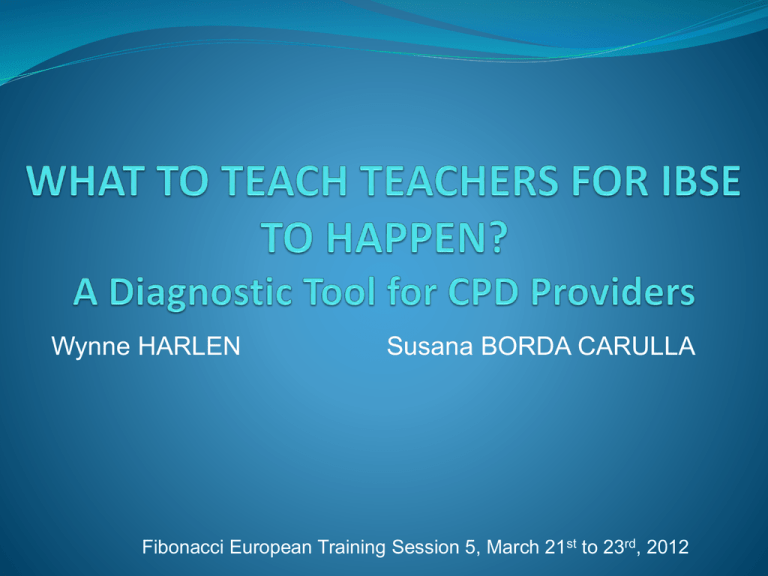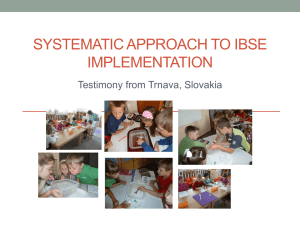HARLEN-BORDA - Introduction to IBSE diagnostic tool
advertisement

Wynne HARLEN Susana BORDA CARULLA Fibonacci European Training Session 5, March 21st to 23rd, 2012 Agenda What is the IBSE Diagnostic Tool for CPD providers? Why an IBSE Diagnostic Tool? The content of the tool How and when to use it Taking action: how to help? What is the IBSE Diagnostic Tool for CPD Providers? List of criteria for judging the implementation of IBSE Through observation and analysis of classroom practices Specific interactions that indicate IBSE DOES NOT cover all aspects of good practice, only those SPECIFIC to IBSE K-9 (children ages 5-13) Why an IBSE Diagnostic Tool? DIAGNOSE CPD requirements, NOT score teachers Identify strengths and weaknesses in IBSE implementation Provide feedback to CPD providers concerning teachers’ training requirements when designing a CPD programme during or after the implementation of a CPD programme (pre-test post-test) Help DEFINE what we mean by IBSE in terms of teaching and learning practices The content of the tool: instructions on planning and coordinating an evaluation Deciding on the objective of the evaluation Selecting and training the observers Planning the class visits Gathering the data Analyzing the data and taking action The content of the tool: forms for data collection LINES Interview with the teacher Section A: Teacher-Pupil Interactions Building on pupils’ ideas Supporting pupils’ own investigations Guiding analysis and conclusions Section B: Pupil Activities The observer The session The class The teacher The topic and objective of the session Carrying out investigations Working with others Section C: Pupils’ Records Any records pupils make of their work Written record COLUMNS (sections A, B, C) : Explanations and examples for each item Making a judgement (Yes, No, NA) Complementary information Using the tool: planning an evaluation Read the instructions carefully! Decide on the objectives of your evaluation Diagnosis or assessment of impact? Are pre-requisites for inquiry in place? Are basic material needs covered? (materials, books, classroom space) Select and train the observers Your observer’s profile How will you interpret each item within your IBSE programme? Training observers as a formative process Plan the class visits Decide on appropriate time of school year for observations Decide on number of consecutive sessions to observe: at least 2 sessions ideally a full sequence Using the tool: gathering the data Explain the purpose of your visit to the teacher: NOT to score them but to identify training needs Before or after the session: interview with the teacher, record data directly on the form During the session: take notes on a separate sheet of paper, record data on the form only AFTER the session Record data on the form quickly after your observation Using the tool: recording the data on the form (Sections A, B, C) 1. Make your judgement for each item: YES means the practice: NO means the practice: • occurred • did not occur at AND all or only rarely • is relevant in the AND context of the • is relevant in the observation context of the observation NA means the practice • did not occur AND • is not relevant in the context of the observation (Content of session? Age of pupils?) 2. Provide qualitative evidence to support all NO and NA judgements Using the tool: examples for NA judgements Items 4e – 4i on the execution of an experimental design: NA for a session where pupils did not actually carry out the experiment because it will happen in the next session Items 7ª - 7e on pupils’ written records: may be NA for kindergartners Analyzing the data Identifying high “No” and “NA” frequencies for each item High “No” frequency: need for attention within the CPD programme High “NA” frequency: are teachers not creating the necessary opportunities for this aspect of IBSE to occur? Need support in building teaching plans? Qualitative data is the key to interpreting quantitative data Analyzing the data Grouping items for analysis Group items according to: The priorities of your CPD programme Actions already undertaken in your CPD programme i.e.: group items 1a, 2a, 2b to focus on appropriate use of questions by teacher and pupils Comparing teaching and learning practices Identify corresponding items in sections A and B (i.e.: items 2e and 4d on “fair testing”) Do “No” judgements correspond? If not, what does this mean? What’s next? Becoming familiarized with the items: “Preparing to observe IBSE” Observing a class session to recover “real” data Analyzing class visits: what can we do with this data? What are the specificities of IBSE in different levels of schooling? Should the tool be used in the same manner in all levels? This is still a work in progress! Any questions? Please focus on questions concerning the use or the general structure of the tool. Questions on specific items and examples will be dealt with in the following workshop. THANK YOU!






![afl_mat[1]](http://s2.studylib.net/store/data/005387843_1-8371eaaba182de7da429cb4369cd28fc-300x300.png)




